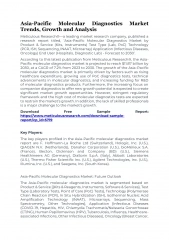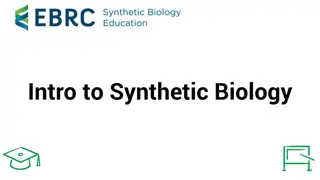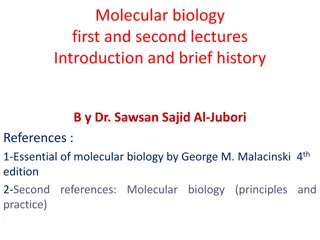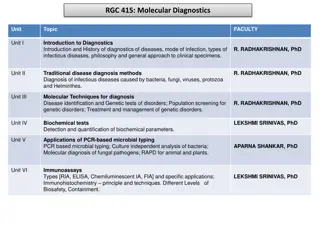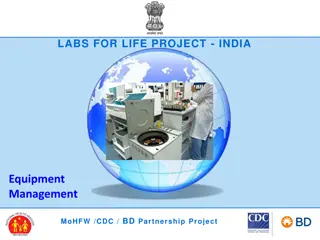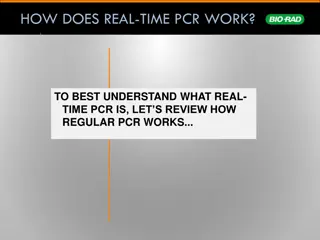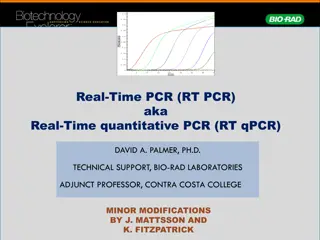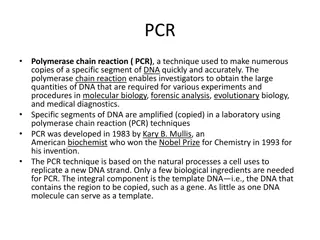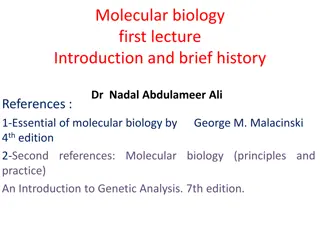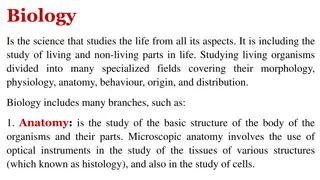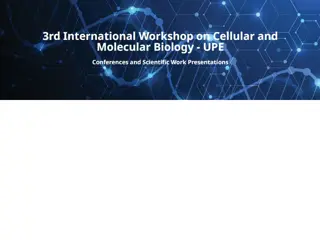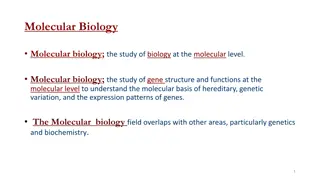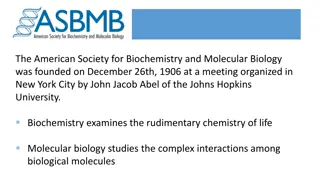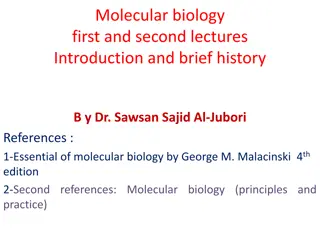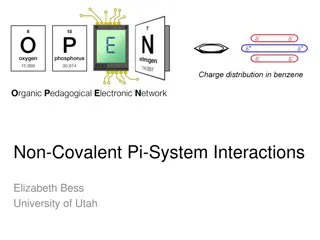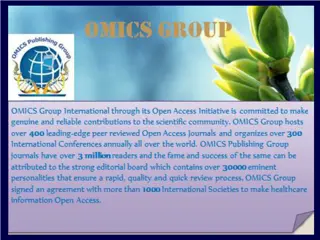PCR: Revolutionizing Molecular Biology
PCR, a groundbreaking technique developed in 1983 by Kary Mullis, amplifies specific DNA sequences with denaturation, annealing, and extension steps. This transformative tool has applications in genetics, forensics, medicine, and biotechnology. The process involves key components like DNA template, primers, DNA polymerase, nucleotides, and buffer solution. Detailed steps include denaturation, annealing, and extension with specific temperatures and times. Through multiple cycles, PCR can create millions of copies of target DNA, aiding in genetic research, forensics, medical diagnostics, biotechnology, and archaeology. Various types like Real-Time PCR, Reverse Transcription PCR, and Nested PCR offer specialized applications in DNA analysis.
Download Presentation

Please find below an Image/Link to download the presentation.
The content on the website is provided AS IS for your information and personal use only. It may not be sold, licensed, or shared on other websites without obtaining consent from the author.If you encounter any issues during the download, it is possible that the publisher has removed the file from their server.
You are allowed to download the files provided on this website for personal or commercial use, subject to the condition that they are used lawfully. All files are the property of their respective owners.
The content on the website is provided AS IS for your information and personal use only. It may not be sold, licensed, or shared on other websites without obtaining consent from the author.
E N D
Presentation Transcript
Introduction PCR is a revolutionary technique used to amplify specific DNA sequences, making it one of the most important tools in molecular biology. Developed by Kary Mullis in 1983, PCR has since transformed various fields, including genetics, forensics, medicine, and biotechnology.
The PCR Process PCR involves three essential steps: Denaturation, Annealing, and Extension. Denaturation: The DNA sample is heated to separate the double-stranded DNA into single strands. 2. Annealing: Primers (short DNA sequences) bind to the specific target sequences on each strand. 3. Extension: DNA polymerase synthesizes new DNA strands by extending from the primers. 1.
Components of PCR Reaction DNA Template: The DNA containing the target sequence to be amplified. Primers: Short DNA sequences complementary to the target region, defining the amplification area. DNA Polymerase: Enzyme responsible for synthesizing new DNA strands. Nucleotides: Building blocks of DNA, used by DNA polymerase to create new DNA strands. Buffer Solution: Provides an optimal environment for PCR reactions.
PCR Steps in Detail Denaturation: Temperature: 94-98 C Time: 20-30 seconds Purpose: DNA strands separate into single strands. Annealing: Temperature: 50-65 C Time: 20-40 seconds Purpose: Primers bind to the target sequences. Extension: Temperature: 68-72 C Time: 20-120 seconds Purpose: DNA polymerase synthesizes new DNA strands from the primers.
PCR Cycles The entire PCR process is repeated multiple times, typically 20-40 cycles. Each cycle doubles the amount of the target DNA. After 20 cycles, one DNA molecule can generate over a million copies!
Applications of PCR Genetic Research: PCR facilitates DNA sequencing, genotyping, and gene expression studies. Forensics: PCR helps analyze DNA evidence in criminal investigations. Medical Diagnostics: PCR enables the detection of pathogens, mutations, and genetic disorders. Biotechnology: PCR is crucial for cloning, mutagenesis, and genetic engineering. Archaeology: PCR aids in ancient DNA analysis and studying evolutionary history.
Types of PCR Real-Time PCR (qPCR): Allows quantitative measurement of DNA amplification during the process. Reverse Transcription PCR (RT-PCR): Converts RNA to cDNA before amplification. Nested PCR: Two rounds of PCR with different primer sets for increased specificity. Multiplex PCR: Amplifying multiple target sequences in a single reaction. Digital PCR: Absolute quantification of DNA using partitioning.
Advantages of PCR Sensitivity: Detects minute quantities of DNA, even from limited samples. Speed: Rapid results within hours. Specificity: Highly specific due to the use of primers. Versatility: Applicable to various DNA sources and target sequences. Automation: Easily automated for high-throughput applications.
Limitations of PCR Contamination: Susceptible to contamination, leading to false results. Primer Design: Proper primer design is critical for specific amplification. Error Rate: DNA polymerase can introduce errors during replication.
PRINCIPLE OF RT-PCR The PCR involves the primer mediated enzymatic amplification of DNA. PCR is based on using the ability of DNA polymerase to synthesize new strand of DNA complementary to the offered template strand. Primer is needed because DNA polymerase can add a nucleotide only onto a preexisting 3 -OH group to add the first nucleotide. DNA polymerase then elongate its 3 end by adding more nucleotides to generate an extended region of double stranded DNA.
Components of PCR: The PCR reaction requires the following components: 1.DNA Template: The double stranded DNA (dsDNA)of interest, separated from the sample. 2.DNA Polymerase: Thermostable Taq polymerase withhigh temperature stability (up to 98 ), and can function at a temperature optimum of about 70 C. 3.Oligonucleotide primers: Short pieces of singlestranded DNA (about 20-30 base pairs) which are complementary to the 3 ends of the sense and anti-sense strands of the target sequence. 4.Deoxynucleotide triphosphates (DNTPs): Single units of the bases A, T, G, and C (dATP, dTTP, dGTP,dCTP) provide the energy for polymerization and the building blocks for DNA synthesis. 5.PCR Buffer system: Includes magnesium and potassium to provide the optimal conditions for DNAdenaturation and renaturation; also important for polymerase activity, stability and fidelity. Composition of10x PCR buffer: 200 mM Tris-HCl (pH 8.4), 500 mM KCl, 50 mM MgCl2.
All the PCR components are mixed together and are taken through series of 3 major cyclic reactions conducted in an automated, self-contained thermocycler machine. 1.Denaturation: This step involves heating the reaction mixtureto 94 C for 15-30 seconds. During this, the double strandedDNA is denatured to single strands due to breakage in weakhydrogen bonds. 2.Annealing: The reaction temperature is rapidly lowered to 54-60 C for 20-40 seconds. This allows the primers to bind(anneal) to their complementary sequence in the template DNA. 3.Elongation: Also known at extension, this step usually occurs at 72-80 C (most commonly 72 C). In thisstep, the polymerase enzyme sequentially adds bases to the 3 each primer, extending the DNA sequence inthe 5 to 3 direction. Under optimal conditions, DNA polymerase will add about 1,000 bp/minute. With one cycle, a single segment of double-stranded DNA template is amplified into two separate pieces of double-stranded DNA. These two pieces are then available for amplification in the next cycle. As the cycles are repeated, more and more copies are generated and the number of copies of the template is increased exponentially
PROCEDURE Real time PCR is a powerful molecular biology technique used to amplify and quantify specific DNA sequences in real time. 1.Sample Preparation: Extract and purify DNA/RNAfrom the sample of interest like cells,tissues,or enviroment sample. 2.Primer and Probe Design:Design specific primers (short DNA sequence) that will anneal to the targetDNA sequence,and a fluorescent probe that binds to the amplified DNA. 3.Reaction Setup:Prepare a PCR reaction mix containing DNA tremplate,primer,probe,Tag DNA polymerase,dNTPs (nucleotide),and buffer. 4.Thermal Cycling:Use a real-time PCR machine that can rapidly Change temperature.The cycling process involves: .Denaturation:Heat the reaction to separate the DNA strands. .Annealing: Cool the reaction to allow primers to bind to the DNA template. .Extension: Raise the temperature to allow DNA polymerase to copy the DNA strand.
PROCEDURE Fluorescence Detection:Dring each cycle,the machine measure fluorescence emitted from the probe as it binds to the amplified DNA .As the DNA amplified,more florescence is produced. 5.Date Collection and Analysis:The machine records fluorescence values after each cycle ,creating a growth curve of DNA amplification.The cycle at which the fluorescence signal crosses a threshold (Ct) is used to quantify the initial amount of target DNA.A lower Ct value indicatemore starting DNA. 6.Calibration and Normalization:To campare results across samples,its common to normalize the target DNA amont to a refernce genes Ct value .This corrects for variations in sample preparation and reaction efficiency. 7.Data interpretation: Analyze the Ct values to determine the relative abundance of the target DNA in different sampes. This can provide insights into gene expression levels,presence of pathogens,or other molecular analyses.
Conclusion PCR has revolutionized molecular biology and continues to be a cornerstone of modern research and diagnostics. Its impact on various fields is profound, making it an indispensable tool for scientists worldwide. THANK YOU



